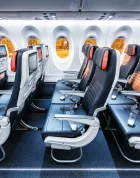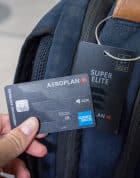Now that’s it’s been a fortnight since the new Aeroplan program has launched, I wanted to follow up my initial posts on the nature of dynamic and preferred pricing and the allowances of complex routings with a closer look at what still doesn’t look right within the new search engine.
While Air Canada and Aeroplan ought to be commended for a relatively smooth transition on November 9 compared to other recent program launches in the loyalty space, there are still a number of ways in which the new program doesn’t yet deliver on their commitments to members at the very start.
Given the program’s messaging about placing trust and transparency above all else, it’s important that we as Aeroplan members hold the program accountable, and I think two weeks since the launch is a fair time to check-in and survey the scenes.
Online Search Engine: More Features to Come
Let’s be clear: the new search engine is a massive improvement upon the old one, adding much-needed features such as support for IATA city codes, greater transparency on mixed-cabin rewards, sorting and filtering by several different criteria, and the very impressive ability to display up to 150 search results in a few seconds’ time.
Compared to what the old Aeroplan offered, I must say I’m getting a quick hit of dopamine very time I put in a search query.
Nevertheless, as we established two weeks ago, the search engine isn’t quite in its true final form just yet, and there are still several missing features that will be added over the coming months.
On a recent livestream hosted by my friend Anshul from Points Miles & Bling, Air Canada Vice President of Loyalty and eCommerce Mark Nasr gave us some projected timelines for upcoming features to be introduced:
- The calendar search feature should be arriving shortly, perhaps by the end of the year
- The much-anticipated Custom Routing tool (which lets members book stopovers online for 5,000 Aeroplan points, as well as build and price out itineraries in the exact same way that Aeroplan call centre agents do) may take at least a few months, and up to a year, to arrive
While the imminent arrival of the calendar search is welcome, the fact that one-way stopovers must be booked over the phone for many more months to come is certainly a hindrance to those of us who’d like to take advantage of this much-advertised benefit of the new program as soon as possible.
Early reports of Aeroplan call centre agents’ familiarity with booking stopovers on one-ways have been decidedly mixed: in both my own attempts to call in complex routings as well as reports by other members, Aeroplan agents seem to say stuff like “nope, you have to pay 5,000 Aeroplan points on top of the two separate awards”, just as often as they’re able to price out a one-way stopover correctly.
Even if we grant that call centre agents may be intimidated by certain very dedicated members calling in with 16-segment routings, it should be a minimum expectation for agents to be able to consistently and accurately price a two-segment one-way bound with a stopover in between, especially when it’s a benefit on which the program has placed great emphasis since the beginning.
Domestic Air Canada Pricing Still Needs Work
There are several domestic Canadian routes where the dynamic pricing model doesn’t conform to the published ranges in the Flight Reward Chart, and still needs a bit of work.
Recall that the published ranges for Air Canada flights are meant to operate as follows:
- The ranges are intended to encompass around 90% of travel dates, with the remaining 10% of dates offering flights that fall either below or above the range in peak and off-peak scenarios, respectively.
- In addition, it was communicated that the amount of seats available at the lower end of the published range is meant to roughly correspond with the amount of fixed-mileage inventory under the previous Aeroplan program, although this guideline applies across the route network rather than on a specific route.
So when there’s a route that consistently prices above the published range, then we know that isn’t conforming to how the published ranges are supposed to work.
One example is Ottawa–Montreal, which clocks in at 94 flown miles and so should cost 6,000–10,000 Aeroplan points in economy class or 15,000–25,000 Aeroplan points in business class during regular times.

However, the pricing is consistently in the range of 13,000 to 17,000 points, or even up to 27,000 points, on this short 30-minute hop. It’s one thing if these exorbitant prices were only showing up on 10% of dates, but it’s in fact showing up throughout every month of the schedule, so we know the pricing definitely needs some tweaking here.

Indeed, you know something is wrong with the pricing when it actually costs less to travel on the same flight to Montreal, and then continue to Quebec City.

Prince of Travel reader Jay points out another incorrectly priced city pair: Vancouver–Sandspit, which, at 468 flown miles in the first distance band, was a much-anticipated sweet spot for travelling to the scenic Haida Gwaii archipelago.

This route is also consistently pricing above the published range of 6,000–10,000 Aeroplan points in economy class; across all months of the schedule, not a single date was found that falls within this range.

Then we get to the problem of Air Canada’s “trunk routes” of Toronto–Vancouver, Montreal–Vancouver, Toronto–Calgary, etc.
These are some of Air Canada’s most popular routes, so it’s somewhat expected for prices to tend towards the higher side of the published ranges, but there are still far too many dates when the prices consistently fall above the published ranges.
For context, all three of these routes fall under the “1,501–2750 miles” distance band in the intra-North America chart, meaning that one-way awards should cost:
- 12,500–17,500 Aeroplan points in economy class
- 20,000–35,000 Aeroplan points in premium economy
- 25,000–60,000 Aeroplan points in business class
Now let’s take October 27, for example, which is about as off-peak as it gets. Let’s look at Toronto–Vancouver first:

- 4 out of 14 flights in economy class fall within the published range (all of which are at 17,500 points, the top end of the range)
- 5 out of 6 flights in premium economy fall within the published range
- 1 out of 14 flights in business class falls within the published range (the 9am departure at 31,100 Aeroplan points)
Taking a look at Montreal–Vancouver:

- 0 out of 5 flights in economy class fall within the published range
- 2 out of 2 flights in premium economy fall within the published range
- 0 out of 5 flights in business class fall within the published range
And then Toronto–Calgary:

- 2 out of 9 flights in economy class fall within the published range
- 1 out of 9 flights in business class falls within the published range
(Note that these prices are based on an Aeroplan member with no Elite Status and no credit card. With preferred pricing in play, some more of the flights may fall within the published range, but that’s beside the point: all Aeroplan members should be able to expect fair pricing based on the published chart, with more engaged members receiving an extra discount as a bonus on that basis.)
Moreover, setting aside the dearth of flights available within the published range, my friend Graham from FlyerMiles.ca notes that the variability of pricing on any given day also doesn’t seem very fair.
Let’s take a look at the cash prices for the first four Toronto–Vancouver flights on the same date as examined above:

All four flights are priced at $426 in economy class, whereas the points price varies between 17,500 points and 26,100 points.
(Looking at the underlying flight loads on ExpertFlyer, there doesn’t appear to be a massive difference in terms of seats available for sale either.)

What gets even more interesting is the variability of pricing in business class: the 7am, 8am, and 9am flights all offer Signature Class lie-flat pod seating, and all three are priced at $1,602 if you were to pay for them in cash.
And yet, on the points side, the 7am and 8am departures are a whopping 100,800 Aeroplan points one-way, while the 9am departure is a more reasonable 31,100 Aeroplan points. What could be the logic behind this 71% difference?!
I will say that I’ve noticed Air Canada has already been working on this matter. A few days ago, similar issues with the published ranges were occurring on dates throughout the spring and summer of 2021 as well, but those prices seem to have now been reduced to fall more frequently int the published ranges.
Nevertheless, the fall 2021 prices remain problematic, and even the spring and summer dates continue to show a concerning level of variability among different flights on the same date. There’s clearly still a bit of tweaking to the algorithm required to ensure that domestic flights within Canada are priced fairly for Aeroplan users going forward.
Diabolical Pricing on Vancouver–Sydney
Many of you will have noticed the outlandishly high pricing on Air Canada’s Vancouver–Sydney route. Throughout most of the schedule, you can expect to pay the princely sum of 500,000+ Aeroplan points for a business class flight down under.

And yes, in case you were wondering, it is possible to see “1.06M Aeroplan points” displayed on the search engine. Flashbacks to the old Aeroplan’s Market Fare rewards, anyone?

The only exceptions tend to be towards the very end of the schedule, where Vancouver–Sydney flights are priced reasonably and bookable in all three cabins.
(I myself snagged a Toronto–Sydney business class booking for 77,500 Aeroplan points per person in early November, which is even a great deal compared to the 80,000 Aeroplan miles plus fuel surcharges that I would’ve had to pay under the old program.)

In the reverse direction, Sydney–Vancouver prices are more reasonable, though still problematic in the sense that they’re consistently pricing above the published range (which would be 45,000–80,000 points in economy class or 75,000–175,000 points in business class).

Thankfully, Mark Nasr confirmed on the recent Points Miles & Bling livestream that the pricing on this specific route is very much the result of “Air Canada being more cautious in the bookings [they] accept”, and is the result of Air Canada’s need to balance their revenue management objectives and their commitment to customers due to COVID-19, rather than any kind of systemic policy change.
There’s a “slippery slope” argument to be made here: if Air Canada is willing to bend its own rules to meet revenue management objectives in this situation, what’s stopping it from doing the same in all other situations going forward?
Personally, I think the strict lockdowns in Australia and New Zealand do represent a significant challenge for airlines, so I can understand why this exception to the pricing policy was made on the Vancouver–Sydney route.
I’m willing to extend Air Canada some largesse on this one, because a trip to Australia during 2021 doesn’t sound too likely anyway, and there are still pockets of seats available to book towards the end of the schedule if you do want to chance it.
The “slippery slope” argument is a valid one on paper, but I wouldn’t give it much weight due to the program’s track record of upholding trust and transparency and addressing members’ concerns promptly, rather than acting surreptitiously against its members’ interests like we’ve seen so many other loyalty programs do in the past.
Case in point…
Good News: Tahiti Will Be “Moved”
One of the new sweet spots that emerged under the new Flight Reward Chart is a Vancouver–San Francisco–Tahiti redemption with the latter leg on United.
This clocks in at 4,989 flown miles, sneaking just under the 5,000-mile threshold for the first distance band of the North America–Pacific award chart.

Thus, a one-way redemption is meant to cost 35,000 or 55,000 Aeroplan points in economy class or business class, respectively – potentially a fantastic deal when you consider that most other frequent flyer programs lump French Polynesia in the same zone as Australia and New Zealand, charging much higher prices as a result.
However, with the new program’s launch, the Vancouver–San Francisco–Tahiti route seems to be pricing incorrectly at 50,000 or 75,000 Aeroplan points in economy class or business class, respectively – as though it was in the second Pacific distance band rather than the first.

For me, this instantly triggered flashbacks of British Airways Avios “moving” Boston and Dublin apart by seven miles, stretching their true distance of 2,993 miles into 3,000 and placing them into a higher distance band, thus eliminating a fantastic sweet spot of flying transatlantic for only 25,000 Avios round-trip.
If you’re going to use a distance-based award chart, after all, you’d better follow the rules of geography!
Air Canada has investigated the matter and concluded that the issue arises due to a discrepancy between the distances provided by the Great Circle Mapper tool and Aeroplan’s underlying Amadeus software.
The lesson? While Great Circle Mapper is a key tool for mapping distances under the new program, it doesn’t appear to line up perfectly with Aeroplan’s distance calculations 100% of the time, so there’s a fair chance that this won’t be the last discrepancy we notice either.
Thankfully, Air Canada also confirmed that they will be manually “moving” Tahiti in the specific case of the Vancouver–San Francisco–Tahiti redemption so that it aligns with members’ expectations and gets priced “correctly” at 35,000 or 55,000 Aeroplan points in economy or business, respectively.
The process may take some time to complete, and I’ll update this section when it’s done. If you were planning a trip to French Polynesia under the new sweet spot, then definitely wait a few weeks until Tahiti has moved into the proper zone before making your booking.
Conclusion
Two weeks after a smooth transition to the new program, there remain a handful of outstanding issues for Aeroplan to address.
The calendar search feature has already been confirmed to be arriving shortly, while it’s my hope that the online multi-city search tool (and the ability to book stopovers for 5,000 points) can be added sooner rather than later. Having said that, it’s understandable that the program wants to make sure the online tools are functioning at a high level before releasing them, so I’d expect the wait to be well worth it.
On the pricing side, many domestic routes still need some tweaking to ensure they are priced fairly and align with the published ranges in the Flight Reward Chart; in addition, if Air Canada wishes to stay true to its goal of offering “predictable pricing”, then it would also be useful to either reduce the sheer variability in pricing on certain trunk routes or help members develop a better understanding of this phenomenon.
Finally, Vancouver–Sydney and Vancouver–San Francisco–Tahiti are two additional anomalies that result from pandemic-era scheduling challenges and a discrepancy in distance calculations, respectively. Neither anomaly ought to remain in the long run.
If there are any other things that still don’t look quite right that I’ve missed, please feel free to let me know in the comments. And to close, I’d remind you that while we’ve focused here on outstanding issues that are generally disadvantageous to us as Aeroplan members, there are also plenty that work in our favour – as usual, I’ll leave it to you to play around with the search engine.




















